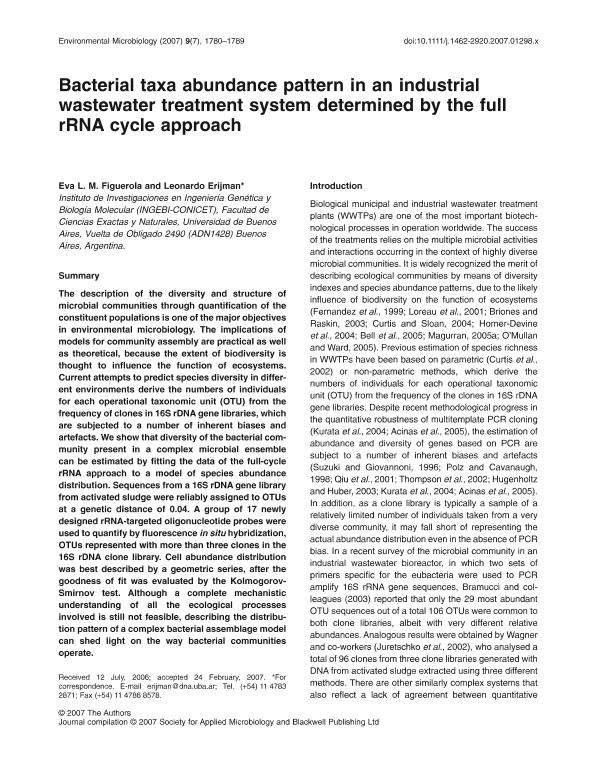Mostrar el registro sencillo del ítem
dc.contributor.author
Figuerola, Eva Lucia Margarita

dc.contributor.author
Erijman, Leonardo

dc.date.available
2019-07-17T13:55:40Z
dc.date.issued
2007-07
dc.identifier.citation
Figuerola, Eva Lucia Margarita; Erijman, Leonardo; Bacterial taxa abundance pattern in an industrial wastewater treatment system determined by the full rRNA cycle approach; Wiley Blackwell Publishing, Inc; Environmental Microbiology; 9; 7; 7-2007; 1780-1789
dc.identifier.issn
1462-2912
dc.identifier.uri
http://hdl.handle.net/11336/79726
dc.description.abstract
The description of the diversity and structure of microbial communities through quantification of the constituent populations is one of the major objectives in environmental microbiology. The implications of models for community assembly are practical as well as theoretical, because the extent of biodiversity is thought to influence the function of ecosystems. Current attempts to predict species diversity in different environments derive the numbers of individuals for each operational taxonomic unit (OTU) from the frequency of clones in 16S rDNA gene libraries, which are subjected to a number of inherent biases and artefacts. We show that diversity of the bacterial community present in a complex microbial ensemble can be estimated by fitting the data of the full-cycle rRNA approach to a model of species abundance distribution. Sequences from a 16S rDNA gene library from activated sludge were reliably assigned to OTUs at a genetic distance of 0.04. A group of 17 newly designed rRNA-targeted oligonucleotide probes were used to quantify by fluorescence in situ hybridization, OTUs represented with more than three clones in the 16S rDNA clone library. Cell abundance distribution was best described by a geometric series, after the goodness of fit was evaluated by the Kolmogorov-Smirnov test. Although a complete mechanistic understanding of all the ecological processes involved is still not feasible, describing the distribution pattern of a complex bacterial assemblage model can shed light on the way bacterial communities operate.
dc.format
application/pdf
dc.language.iso
eng
dc.publisher
Wiley Blackwell Publishing, Inc

dc.rights
info:eu-repo/semantics/openAccess
dc.rights.uri
https://creativecommons.org/licenses/by-nc-sa/2.5/ar/
dc.subject
16s
dc.subject
Bacteria
dc.subject
Biodiversity
dc.subject
Gene Library
dc.subject
In Situ Hibridization
dc.subject.classification
Biología Celular, Microbiología

dc.subject.classification
Ciencias Biológicas

dc.subject.classification
CIENCIAS NATURALES Y EXACTAS

dc.title
Bacterial taxa abundance pattern in an industrial wastewater treatment system determined by the full rRNA cycle approach
dc.type
info:eu-repo/semantics/article
dc.type
info:ar-repo/semantics/artículo
dc.type
info:eu-repo/semantics/publishedVersion
dc.date.updated
2019-07-15T13:57:56Z
dc.journal.volume
9
dc.journal.number
7
dc.journal.pagination
1780-1789
dc.journal.pais
Reino Unido

dc.journal.ciudad
Londres
dc.description.fil
Fil: Figuerola, Eva Lucia Margarita. Consejo Nacional de Investigaciones Científicas y Técnicas. Instituto de Investigaciones en Ingeniería Genética y Biología Molecular "Dr. Héctor N. Torres"; Argentina. Universidad de Buenos Aires. Facultad de Ciencias Exactas y Naturales; Argentina
dc.description.fil
Fil: Erijman, Leonardo. Consejo Nacional de Investigaciones Científicas y Técnicas. Instituto de Investigaciones en Ingeniería Genética y Biología Molecular "Dr. Héctor N. Torres"; Argentina. Universidad de Buenos Aires. Facultad de Ciencias Exactas y Naturales; Argentina
dc.journal.title
Environmental Microbiology

dc.relation.alternativeid
info:eu-repo/semantics/altIdentifier/doi/http://dx.doi.org/10.1111/j.1462-2920.2007.01298.x
dc.relation.alternativeid
info:eu-repo/semantics/altIdentifier/url/https://onlinelibrary.wiley.com/doi/abs/10.1111/j.1462-2920.2007.01298.x
Archivos asociados
